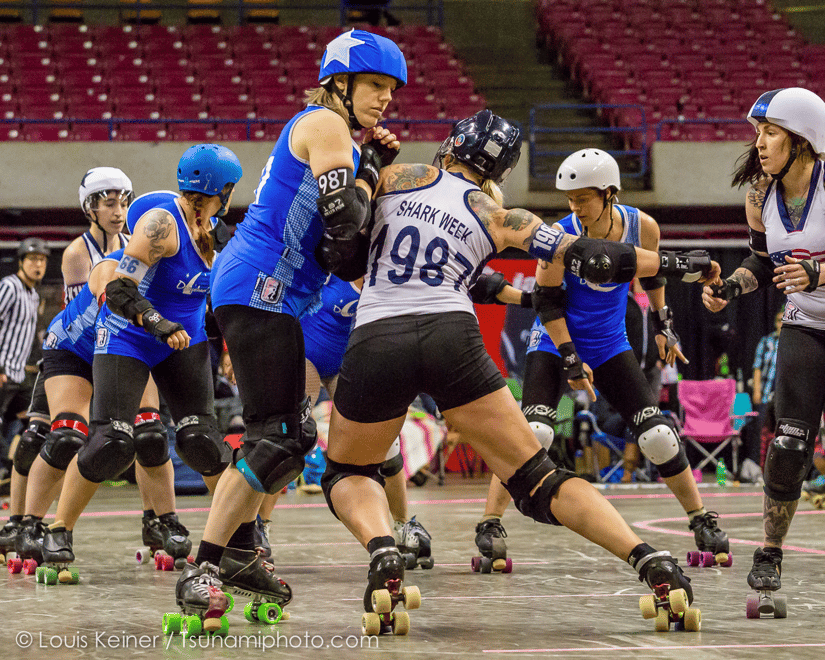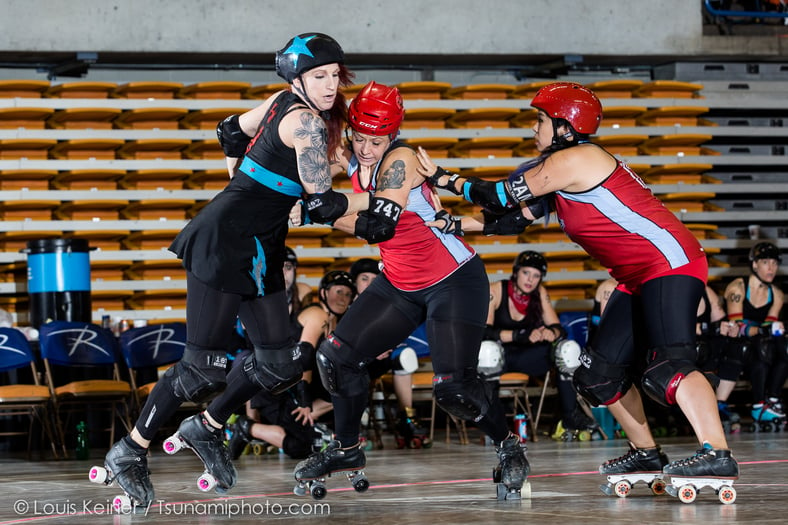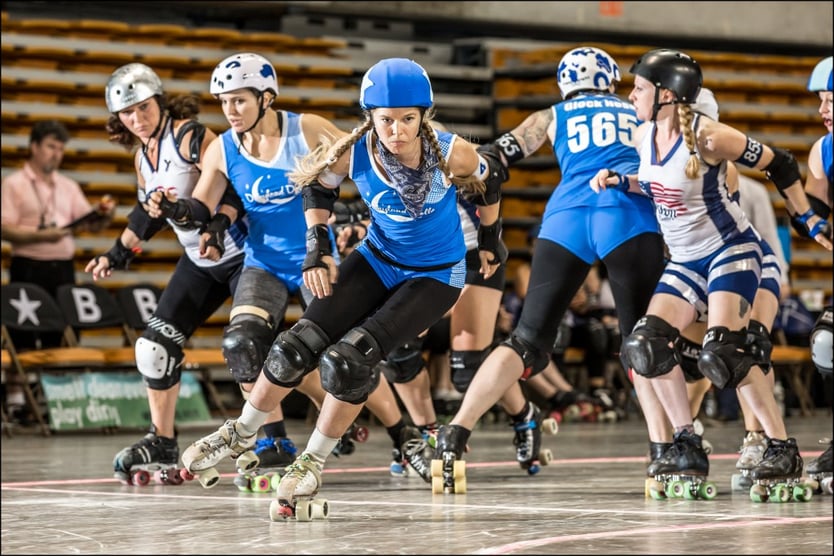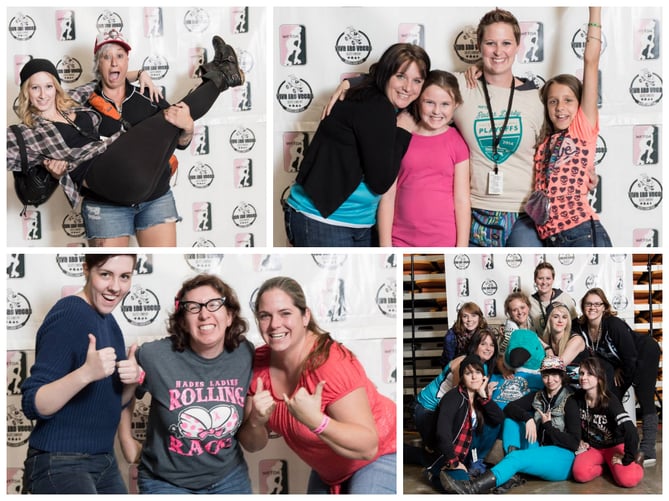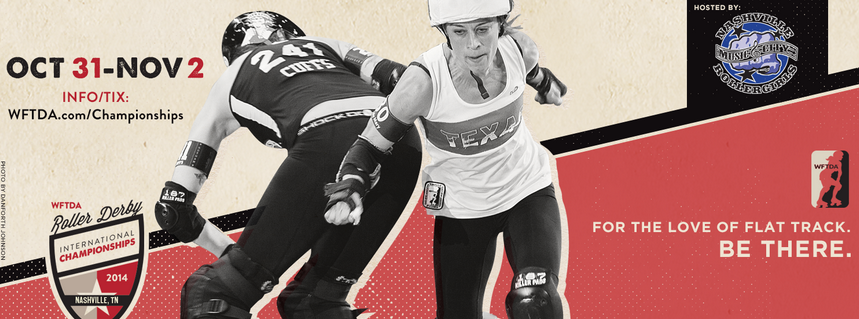Women’s flat track roller derby is a relatively young sports discipline, but it has already gained a lot of international recognition, not only among sport aficionados but also journalists. Women’s Flat Track Derby Association (WFTDA) managed to create a modern image of the derby in US and worldwide, and continues to grow a strong community around it.
I’m talking to Erica Vanstone (Director of Broadcast Operations of WFTDA) about the origins of the discipline, recent success with the pay-per-view tournaments, and the plans for the future.
Monika Zameta: What are the origins of the Women’s Flat Track Derby Association (WFTDA), and how does Roller Derby, as it is now, follow in the footsteps of the roller derby we knew from the 70’s?
Erica Vanstone.: Roller derby in the old days was something completely different than it is today, and I think that it’s both an asset and a challenge for us. What people remember about roller derby within the past thirty years is a lot different from what we’re doing today.
In 2015 the WFTDA will be ten years-old. In 2005 there were a handful of leagues that decided they would come together because all of them were kind of loosely playing the same rules set.
Their goal was to figure out how to best work together to leverage a collective agreement, if you will, that turned into the governing body for the sport. So what they did was to create the WFTDA out of a coalition formatted in 2004, and since then they’ve been opening it up. So, in 2005 there were 20 leagues that came together.
The roller derby that developed in early 2004 and 2005 - was something that anyone could do.
The flat track could be set up anywhere at a low cost, without the need for a huge crew to move it between the competitions. Thanks to this accessibility, flat track took off very quickly.
Today we have 260 member leagues and 104 apprentice leagues around the world. The apprentice leagues are leagues who are working to fulfill their membership requirements.
What people usually remember from the past about roller derby is that it was much more like professional wrestling then what you see now. A lot of the teams used banked tracks, and women and men would compete together. But overall, it was about skating around and knocking each other down.
We now have rules that have ushered flat track roller derby into the competitive sport category, as opposed to simply being a show. For example, you can’t hit somebody in the face or trip them.
The goal of modern roller derby is to get past the opposing skaters to score points. It’s one of the only sports where players are actively doing offence and defense at the same time. Flat track roller derby is as legitimate a sport as you can find.
M.Z.: You take pride in the mentorship. Do you also see it as your biggest achievement?
E.V.: Yes, that and the rules of flat track roller derby are our biggest assets. I’m also very proud oft he image we’ve worked to create around this discipline, especially within the community. People used to approach us, asking what’s so appealing about roller derby.
They used to say, “So, you’re basically on skates hitting each other. What can be attractive about that?” What we’ve actually developed is a sport that thrives on skaters pushing themselves to achieve things they might not have thought possible as a woman. When skaters start to understand that, a whole new world of athletics opens up to them.
We’re very much focused on trying to make the best rule set that we feel can be developed for this sport, and on trying to generate interest. Our community of viewers right now is centered around the people who are directly involved in roller derby.
We’d like to eventually reach the point where we can get distributors who are outside of our online channel interested in our content.
M.Z.: You’ve mentioned that almost everyone can create a flat track and start training. Does that also mean you’re involved in training the future generations of flat track rollers at schools or universities?
E.V.: In Philadelphia, my home league has what’s called a ‘fresh meat’ rookie program that I also went through. Several years ago when I found out I was pregnant, all of my thoughts about becoming a skater were put on hold for a while. So I announced for a couple of years and then I became a referee. This past year, I started skating with the Philly Roller Girls in Philadelphia, and our league is pretty much involved in teaching a juniors program for young women. On a league-to-league basis, there’s a lot of education going on.
A lot of leagues have what they call recreational leagues for roller derby - where there are no requirements to join – and it’s more like a fitness class than an athletic club. I believe that the educational part of our activities will be more and more important in the future.
Cleeng also plays a big role in the education of our members because people can learn by watching the live events - thanks to Cleeng. We also archive hundreds of WFTDA bouts on You Tube and that’s where people learn about the sport.
M.Z.: What conditions need to be fulfilled to be accepted into your junior program?
E.V.: I would go to WFTDA.com and take a look at the leagues that are closest to you, and then I would contact them and learn more about the process because every league has a slightly different way of recruiting and training new members. WFTDA.com has the rules of the sport, too, so you can also learn more about that.
M.Z.: You’ve mentioned that Cleeng helps you reach and educate your audience. How did you find out about Cleeng, and what has convinced you to give Cleeng a try?
E.V.: Two years ago we developed a new website, WFTDA.tv and worked with PPV as a way to fund our productions. So we kind of created our own custom solution. Last year we had a lot of issues with this solution, especially with a custom code, server loads and stability of the entire system.
Cleeng was recommended to us by our producing partner, Blaze Streaming Media out of Portland, Oregon; as a product that could cover our needs. We did a bit of research and figured out that you guys provide not only the stability we were looking for, but also customer support.
M.Z.: What has been your experience with PPV so far?
E.V.: We have three divisions within the WFTDA we present online. The division 1 is the top tier of roller derby skills, the crème de la crème. Division 2 is the forefront of the roller derby, and then there’s division 3, which typically represents newer or smaller leagues looking to become established and learn about the sport.
We added two Division 2 tournaments last year, and we streamed them for the first time, as many people didn’t understand how fun and competitive Division 2 roller derby is to watch.
Photo by Tyler Shaw
This year we decided to monetize Division 2 at a good price point - $7 per weekend access. The match-ups were incredible. I think it’s not so important to us that the monetization has been successful, but rather, that the division playoffs this year proved to our community that the rankings structure is really working out.
Also, we’ve had very few complaints concerning the challenges of the back-end of monetization, as they were all resolved for us by Cleeng. People weren’t communicating issues (as there were only a few small ones) to us, but instead they were able to focus on enjoying the game and cheering for the rollers.
M.Z.: Can you tell us more about the community surrounding roller derby, including the online roller derby community? We’ve noticed a lot of fans using the hashtags you created while setting up the event with us and being very active on social media.
E.V.: Roller derby is a micro and macro community. Within your city or town, you will see a micro community of the leagues. You get out of it what you’ve put into it. You can come and volunteer and be involved at a granular level. And then the WFTDA is the parent organization for those leagues. They work really hard to put on events that represent the quality of the sport, including through broadcast. This would be our macro community.
What’s truly phenomenal about our community is that we’re highly engaged via social media. We’re very passionate and communicative among ourselves on a regular basis. There’s an expectation now that, whenever we broadcast the tournaments, there has to be some outlet for discussing it.
People want to see other people talking about the game they’re watching. We learned this lesson a long time ago, and this is why our community engagement is expressed so vividly on Twitter, Facebook and Instagram. Roller Derby has grown up in the digital age, and it is organically connected to the digital community.
M.Z.: What’s your ambition for the coming months?
E.V.: We’d like to continue our international growth and see even more people participating worldwide. The first Australian league made it to Division 1 Playoffs - Victorian Roller Derby. - last year, and in 2014, they’re back at an even higher seeding, which is outstanding. So we’re always trying to create tools and offer resources to leagues that aren’t based in the United Stands, and WFTDA Broadcast is one way we try to do that.
In 2014, we’re also looking to create as flawless an online experience as possible for those streamed events. Every year we try to be better at managing the variables that go into live broadcasts. After the playoffs is when we take a step back and look at what we want to do better in the coming season.
This year, for example, we started creating highlight reels and sending them to the media, because we want to get on everyone’s radar. We’ve done a lot of work with national sports media in the U.S. and globally, but there’s still that block to overcome as a women’s sport that we’re not yet being taken seriously by larger outlets.
We hear all the time that there’s no market for derby, but we’re proving that’s not true. And the reason why I think that is because I believe roller derby offers both the women who play it and the fans who watch something extraordinary.
If you compare it with, for example, Major League Baseball--which was architected for men and where women like Little League World Series pitcher Mo’ne Davis probably won’t have a chance to succeed (even though the MLB ban against women was lifted in 1992)--you can see how women don’t even consider the MLB as an option. Instead, women like Mo’ne would be funneled through the ranks of softball, which is a completely different rules set.
Since roller derby is a sport created and maintained by women, it allows you to go as far as you want to go. The world needs to be ready to hear that. Women crave that opportunity to be challenged and I think we’re close to having that recognized in a bigger way. My dream is to prove to people that there’s a market for this because of how special it is, and that both women and men will enjoy watching it.
----
*All photos by courtesy of http://wftda.com

